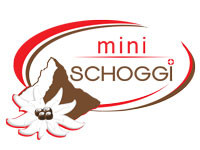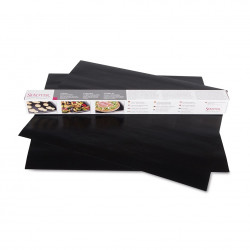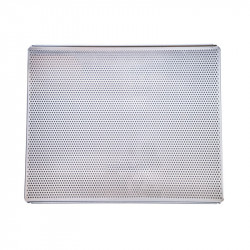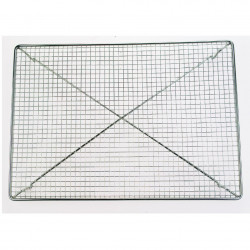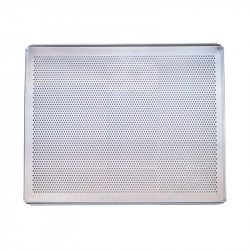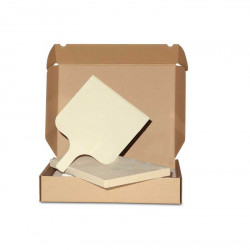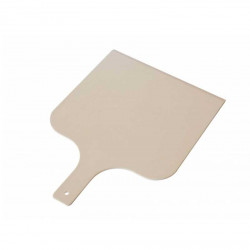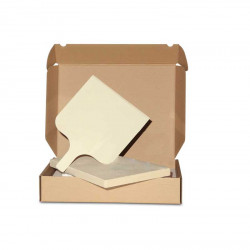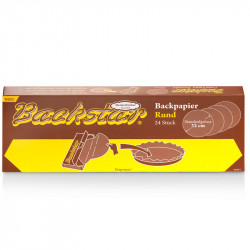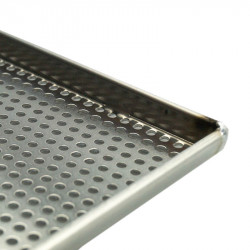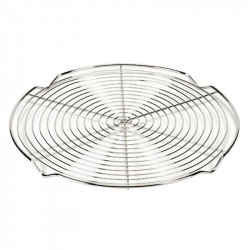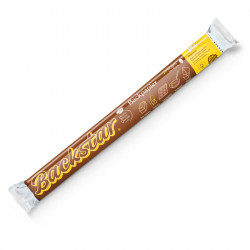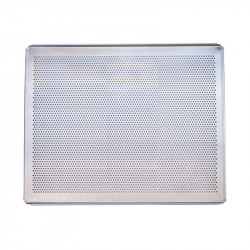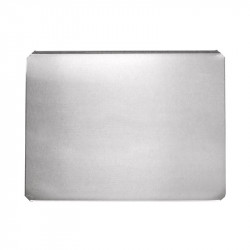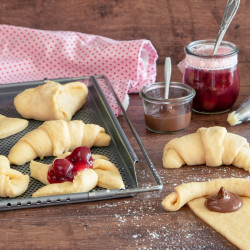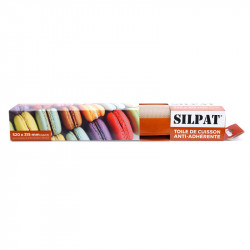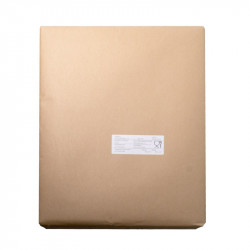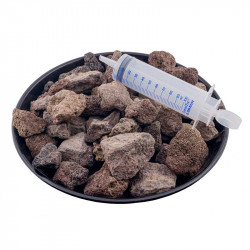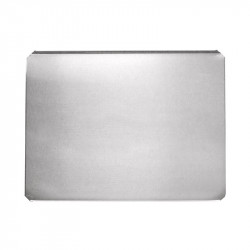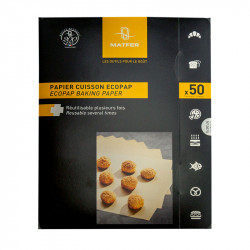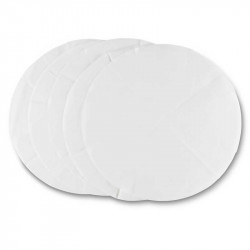Baking tray & baking paper
What is a baking paper?
A baking paper is a specially coated paper used for baking food. It is used to prevent dough or other food from sticking to the baking pan or tray. Baking paper is heat resistant and is easy to cut and shape. It can also be used several times before being discarded. When baking with baking paper, it is not necessary to grease the mold or tray, because the baking paper has a non-stick effect.
How many different baking papers are there?
There are different types of baking paper, depending on the specific use or manufacturer. Some common types of baking paper are coated baking paper, silicone baking paper, parchment paper and butter paper. However, there is no exact number of different types of baking paper, as new varieties may be developed and availability may vary by region or manufacturer.
Which baking paper is for what?
There are different types of baking paper that are suitable for different purposes:
1. Standard baking paper: This is the most commonly used baking paper and is suitable for many baking applications such as baking cookies, cakes and rolls.
2. Silicone-coated baking paper: This baking paper has a special silicone coating that prevents food from sticking to it. It is especially good for sticky or greasy foods such as cheesy pastries, greasy chicken wings, or fish sticks.
3. Non-stick baking paper: This baking paper is similar to the silicone-coated baking paper, but with an added non-stick coating. It is especially good for delicate baked goods such as sponge cake rolls or soufflés.
4. Parchment paper: Parchment paper is a special baking paper made from a thin, greaseproof paper. It is especially good for cooking fish or vegetables in parchment paper or for steaming food.
5. Reusable Baking Paper: This baking paper is made of a heat-resistant silicone coating on a flexible fiberglass backing. It can be used multiple times and is more environmentally friendly than disposable baking paper.
It is important to choose the right baking paper for each application to achieve optimal baking results.
How should a baking paper that is no longer used be disposed of?
Baking paper that is no longer used can be disposed of like normal waste paper. It should be thrown into the waste paper bin or placed in the paper waste. It should not be soiled with food residues or grease, as this may affect its recyclability.
How much heat can a baking paper withstand?
Baking paper can withstand temperatures of up to 220 degrees Celsius. It is important to follow the manufacturer's specific recommendations, as resistance to heat may vary depending on the brand and quality of the baking paper.
Is a baking paper harmful?
No, baking paper is usually not harmful. It is made of unbleached kraft paper and coated with a thin layer of silicone to prevent food sticking. As long as it is used according to instructions and does not come into direct contact with an open flame, it is safe for food use. However, it is always advisable to check the use of baking paper and ensure that it complies with current safety standards.
What is there as a substitute to the normal baking paper?
As a substitute for normal baking paper, there are several options:
1. Buttered baking paper: Buttered baking paper can be used as a substitute for baking paper, as it often has similar properties. However, it is important to note that it may not be as heat resistant as baking paper.
2. Silicone baking mat: A silicone baking mat is reusable and can be used in place of baking paper. It is heat resistant and prevents food from sticking.
3. Glass or Porcelain Baking Mats: These special glass or porcelain baking mats can be used instead of baking paper. They provide a smooth surface on which food can be baked.
4. Baking Spray: A baking spray can be sprayed on the baking pan or tray to prevent food from sticking. However, it is important to follow the manufacturer's instructions.
5. Aluminum foil: In some cases, aluminum foil can be used as a substitute for baking paper. However, it should only be used for certain applications as it conducts heat differently than baking paper.
It is important to note that not all of these alternatives have the same non-stick effect as baking paper and it is therefore advisable to follow the respective instructions for use.
What is a baking tray?
A baking sheet is a flat, rectangular metal sheet that is usually used in an oven. It is used to evenly bake foods such as cakes, cookies, pizza or rolls. A baking sheet usually has a non-stick coating to prevent food from sticking. You can also use it to grill meat or vegetables.
Which baking sheet is best for baking?
There are different types of baking sheets that can be used for different purposes in baking. Here are some options:
1. Standard Baking Sheet: This is the common baking sheet used in most households. It is usually made of aluminum or stainless steel and has a flat bottom. It is good for baking cakes, cookies and other sweet treats.
2. Silicone baking mat: These are made of silicone and have a non-stick surface. They can be used as a substitute for a traditional baking sheet as they prevent the baked goods from sticking. The silicone baking mat is also easy to clean and reusable.
3. Grid: A grid is made up of metal bars arranged in a grid pattern. It is often used for baking rolls, bread or for cooling pastries, as it allows air to circulate, ensuring even browning.
4. Earthenware or ceramic tray: This type of baking tray has the advantage of retaining heat well and distributing it evenly. It is especially good for baking bread because it produces a crispy crust.
Choosing the best baking sheet depends on personal preference and intended use. Aluminum or stainless steel baking sheets are an excellent choice in most cases.
How to clean a baking tray?
There are several ways to clean a baking tray. Here is a simple method:
1. First remove coarse dirt, such as leftover food, with a sponge or spatula. Throw these remnants in the trash.
2. Fill the baking tray with hot water and add some dishwashing liquid. Let the water soak for a while to loosen stuck-on grime.
3. Take a sponge or soft brush and scrub the baking sheet thoroughly to remove food scraps and crusting. Be sure to clean all areas of the sheet, including the edges.
4. Rinse the baking sheet thoroughly with clean water to remove all soap residue.
5. For stubborn crusts, you can make a mixture of baking soda and water and apply it to the baking sheet. Let the mixture sit for a few hours and then rinse thoroughly.
6. Dry the baking sheet thoroughly before reusing or storing it.
There are also special baking sheet cleaners on the market that can help with stubborn stains. However, it is important to follow the instructions of the specific cleaner.
What is the difference between a perforated tray and a normal baking tray?
A perforated tray and a normal baking tray differ mainly in their structure and function.
A normal baking tray is usually made of a flat, rectangular piece of metal. It has a raised edge to catch liquids and crumbs, and a smooth surface for baking various foods such as cookies, bread, or cakes.
A perforated tray, on the other hand, is made of metal with many small holes or cutouts. These holes are used to improve air circulation during baking. As a result, heat is distributed efficiently and the result is more even and crispy. Perforated trays are often used for baking pizza or baguettes, as they produce a better crust.
In summary, a normal baking tray has a smooth surface and can be used for various baked goods, while a perforated tray has many small holes and is used for baking foods where even heat distribution and a crispy crust are important.
How should I dispose of a broken baking tray?
A broken baking tray can usually be disposed of with household waste. It is advisable to break or fold the baking tray into smaller pieces to avoid possible injury. However, also be aware of local disposal regulations, as they may vary depending on where you live. Some communities also offer special disposal options for metal waste, such as recycling yards or recycling stations. It's best to check with local disposal authorities to make sure you're disposing of the baking sheet correctly.
What material should a baking tray be made of?
A baking tray should ideally be made of a material that provides good heat conductivity and even heat distribution. Common materials for baking trays are stainless steel, aluminum and enamel. Stainless steel is sturdy and durable, while aluminum has good heat conductivity. Enamel-coated trays are easy to clean and offer better non-stick performance. It is important that the baking sheet material is suitable for oven use and can withstand the temperatures that can be reached during baking.
What exactly is a Teflon coating and does it need it on the baking tray?
A Teflon coating consists of a thin layer of the non-stick material Teflon, a brand for the polymer polytetrafluoroethylene (PTFE). This coating is often applied to cookware and bakeware to prevent food from sticking to it.
The Teflon material is known for its non-stick properties, which makes cooking and baking easier and cleaning dishes simpler. It prevents food residues from sticking to the surface and increases the durability of the dishes.
A Teflon coating is used on the baking tray to prevent dough or other foods from sticking to the surface during baking. This makes it easier to remove the baked food and makes it easier to clean the tray.
It is important to note that a Teflon coating can decompose at high temperatures (above 260 °C) and potentially release toxic fumes. Therefore, Teflon-coated baking sheets should not be heated beyond their maximum temperature limit.
What size of baking tray fits in my oven?
To find out what size of baking tray will fit in your oven, you need to know the internal dimensions of the oven and the size of the baking tray.
Measure the width, the height and the depth of the interior of your oven.
The baking sheet should be smaller than the oven's interior dimensions to leave enough room for convection cooking.
Usually, baking trays with a size of 40 x 30 cm (Euro trays) fit into most standard ovens.
However, it is advisable to check the exact dimensions of your oven and the specific size of the baking tray you want to use to make sure it fits well.
